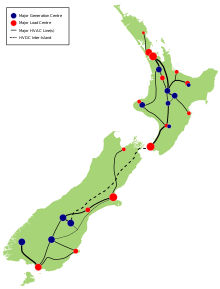HVDC Inter-Island Link
The HVDC Inter-Island Link is a high-voltage direct current (HVDC) transmission line between the South and North Islands of New Zealand . The main purpose of the line is to transmit electrical energy generated from hydropower on the South Island to the North Island. The line is operated by Transpower New Zealand . The cables, including the approximately 40 km long submarine cable between the islands, were laid by British Insulated Callender's Cables (BICC). The HVDC was put into operation in 1965 with mercury vapor rectifiers built by Asea Brown Boveri (ABB) . In 1991 there was a changeover to thyristors .
The line begins on the South Island at the Benmore power station in the Canterbury region , comprises an overhead line of 535 km, crosses the Cook Strait as a submarine cable with a length of 40 km and ends in Haywards near Wellington on the North Island.
The power transmission line is designed as an asymmetrical, bipolar line, which is operated with two separate poles due to the asymmetry: pole 1 was operated with a direct voltage of +270 kV and pole 2 with −350 kV.
A new power line called Pole 3 has been in operation since 2013. This new route replaced the 46-year-old Pol 1 route. This increased the maximum transmitted power from 900 MW to 1200 MW.
Web links
- HVDC Inter-Island Link Project . (PDF 1.6 MB)Trustpower New Zealand,accessed on January 18, 2016(English).
Individual evidence
- ^ Siemens completes HVDC transmission link for New Zealand . Siemens , accessed August 15, 2014 .
- ^ HVDC Inter-Island Link Project . Trustpower New Zealand , archived from the original on February 10, 2013 ; accessed on April 13, 2018 (English, original website no longer available).

